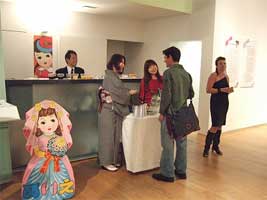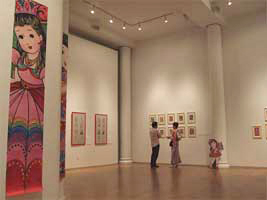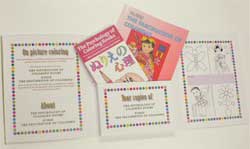 September 21 - October 3, 2009 at Tenri Cultural Institute of New York New York, USA NURIE:The Japanese Picture Coloring Exhibition
S ince 2006, the "Kiichi Nurie Exhibit," representative of Japanese nurie, has been displayed abroad annually. Exhibits were held in New York in 2006, Karlsruhe, Germany in 2007, and Paris in 2008. In 2009, New York was chosen as the site for a nurie exhibit for the second time.This most recent New York nurie exhibit took place at the New York Tenri Cultural Institute, close to Union Square. For this second exhibition in New York, I hoped to have the pictures seen by the art world in New York, and a number of prominent individuals attended, including Andy Warhol's assistant Benjamin Liu, currently working as a director, United Bamboo designer Miho Aoki, Miho Hatori, singer for the group Chibo Matto, as well as other top-ranking product designers, journalists, and producers. I was delighted to hear admiration, expressed through words such as "kawaii," [cute] "cute" and "beautiful," from all who attended. In New York these days, where Japanese food is popular, genuine Japanese flavors are understood and appreciated. In much the same way, I felt quite strongly that the notion of "kawaii" was perceived much more directly compared to the 2006 exhibit. 
A banner which hung in the spacious exhibition area to highlight the nurie featured an enlargement of a colorful picture from a nurie cover. The vivid colors created a captivating display. Those who attended were able to properly admire the nurie as small, individual images, and fully grasp the notion of kawaii captured in the atmosphere created through the eyes, charm and mannerisms of the Kiichi girls. I sensed that the gestures, facial expressions. and coloring that characterize Kichii kawaii manifested their charm in New York even more this time, touching and capturing the hearts of those who saw them. I am involved both in introducing Japanese nurie abroad and investigating coloring pictures in foreign countries. I collect data from kindergartens, publishing companies, libraries and bookstores in local areas, searching for the actual circumstances of the coloring pictures in each country. The surprising thing I have come to realize is that, even though coloring pictures is something that children in foreign countries have been doing since long ago, there are no books or studies on coloring books in the libraries of any representative large city you might visit, such as New York, Paris, Berlin or Tokyo, either in Japan or abroad. Because of this, I thought it might be worthwhile to introduce the book "Nurie Culture," a study on Japanese nurie, to a foreign audience, so I decided to look for an English language publishing company. Nurie is art, but depending on the history and culture of each country, there is also culture in nurie. "Nurie Culture" might serve as an impetus to get people thinking about coloring pictures in their own countries. We might also thing of coloring pictures as a valuable tool for reconnecting with our precious childhood years. It is my hope that through this exhibition and book, the charm of nurie will spread further in New York, and throughout the world as well. All You Ever Wanted to Know About Nurie
The new set of books Nurie; The Fascination of Coloring and the Psychology of Coloring Books by Masa Kaneko and Kikuo Yamamoto explores the background and benefits of this ancient art from. the former was the world's first specialized book on picture coloring, and it discusses the art's origins as well as how it evolved into its current form. It also talks about future applications and its connections to phenomena such as manga. The Psychology of Coloring Books contains observations on the psychology behind this art, such as perspectives on children, parents, coloring picture creators and scholars, as well as a comparative examination of coloring books and children’s picture books. | ||
|

